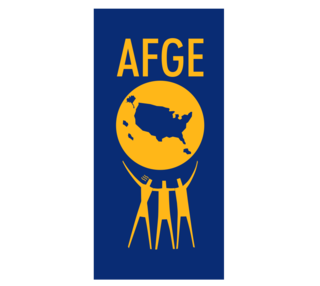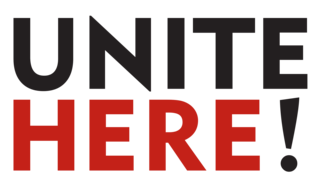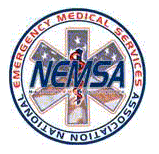
Service Employees International Union (SEIU) is a labor union representing almost 1.9 million workers in over 100 occupations in the United States and Canada. SEIU is focused on organizing workers in three sectors: healthcare, including hospital, home care and nursing home workers; public services ; and property services.

The American Federation of Government Employees (AFGE) is an American labor union representing over 750,000 employees of the federal government, about 5,000 employees of the District of Columbia, and a few hundred private sector employees, mostly in and around federal facilities. AFGE is the largest union for civilian, non-postal federal employees and the largest union for District of Columbia employees who report directly to the mayor. It is affiliated with the AFL–CIO.

The Canadian Labour Congress, or CLC is a national trade union centre, the central labour body in Canada to which most Canadian labour unions are affiliated.

UNITE HERE is a labor union in the United States and Canada with roughly 300,000 active members. The union's members work predominantly in the hotel, food service, laundry, warehouse, and casino gaming industries. The union was formed in 2004 by the merger of Union of Needletrades, Industrial, and Textile Employees (UNITE) and Hotel Employees and Restaurant Employees Union (HERE).

The National Emergency Medical Services Association (NEMSA or National EMS Association) is a now defunct, registered labor union and California non-profit mutual benefit corporation. NEMSA's membership consists of emergency medical technicians (EMTs), and paramedics.
The California State Employees Association (CSEA), was founded in 1932 in Sacramento, California. The organization itself grew out of a campaign to pass a ballot initiative to amend the California state constitution to create a retirement system for California state workers. As a result of the campaign, the core of leadership for the campaign went on to create the association to maintain the momentum of that political victory by forming a credit union, now known as The Golden One Credit Union, for state employees, winning voter approval of the merit system for state civil service, and a 40-hour workweek and, finally in 1979, winning collective bargaining rights for state and university employees in the California legislature, also known as the Dills Act after its author Senator Ralph C. Dills. When California adopted collective bargaining for state employees in 1979, CSEA began a long period of reorganization wherein its members were divided into four distinct classes depending on their employment or retirement status with the State of California. Ultimately, each of the four classes of members formally incorporated their respective organizations within the pre-existing corporate structure of CSEA as affiliates of CSEA. Each of these four affiliates have assumed authority for their respective member representation programs. CSEA now only provides business services of accounting, IT and member benefits for the four affiliated organizations which represent active and retired state and California State University system employees. CSEA governance is currently an eight-member board of directors composed of two representatives from each of the four affiliates. The board of directors elects its officers, as required by California corporate code, from among these eight board members.

Louisville Metro Emergency Medical Services is the primary provider of pre-hospital life support and emergency care within Louisville-Jefferson County, Kentucky. LMEMS is a governmental department that averages 90,000 calls for service, both emergency and non-emergency, each year.

The United Nurses and Allied Professionals (UNAP) is a labor union in the United States which represents approximately 5,500 registered nurses, technologists, therapists, support staff, and other health care workers employed in Rhode Island, Vermont, and Connecticut.

SEIU Healthcare is a Canadian trade union representing more than 60,000 workers in Ontario, Canada. Through collective bargaining, the union represents workers in hospitals, home care, nursing and retirement homes, and community services. The union has been active in Ontario for over 70 years.

The Pennsylvania Association of Staff Nurses and Allied Professionals (PASNAP) is a labor union in Pennsylvania that represents about 8,300 nurses and allied health professionals.
The California Nurses Association/National Nurses Organizing Committee (CNA/NNOC), an affiliate of National Nurses United, is a trade union labor union and professional association of registered nurses in the United States. Since 2018, CNA/NNOC has been led by Executive Director Bonnie Castillo, RN.

The American Federation of State, County and Municipal Employees (AFSCME) is the largest trade union of public employees in the United States. It represents 1.3 million public sector employees and retirees, including health care workers, corrections officers, sanitation workers, police officers, firefighters, and childcare providers. Founded in Madison, Wisconsin, in 1932, AFSCME is part of the AFL–CIO, one of the two main labor federations in the United States. AFSCME has had four presidents since its founding.
George Hardy was a Canadian-American labor leader who was president of the Service Employees International Union (SEIU) from 1971 to 1980. At the time of his death, SEIU had grown to become the fifth-largest affiliate of the AFL-CIO. Hardy was a vice president of the AFL-CIO from 1972 to 1980, and a member of its executive council. He was a former member of the Democratic National Committee and the California Democratic State Central Committee.

Workers United is an American and Canadian labor union which represents about 86,000 workers in the apparel, textile, commercial laundry, distribution, food service, hospitality, fitness and non-profit industries. It was established in its current form in 2009 and is affiliated to the Service Employees International Union (SEIU).
Locke v. Karass, 555 U.S. 207 (2009), is a court case in which the Supreme Court of the United States held that the Constitution permits the local chapter of a labor union to charge a "service fee" to non-members to cover non-local litigation expenses if (a) the expenses are "appropriately related to collective bargaining" and (b) there is a reciprocal relationship between the local chapter and the national union. The case expanded on and clarified the earlier Lehnert v. Ferris Faculty Association, which permitted such service fees for non-political activities but did not reach a consensus on whether "national" expenses were chargeable.

Mary Kay Henry is an American labor union activist who was elected International President of the Service Employees International Union (SEIU) on May 8, 2010. She is the first woman to lead the union. While serving with the union in California, she helped pioneer SEIU's use of card check agreements, non-traditional collective bargaining agreements, comprehensive campaigns, and system-wide health care organizing strategies. Henry was included on Time's 100 Most Influential People of 2020.

United EMS Workers-AFSCME Local 4911 is a labor union representing EMS workers. Members include Emergency Medical Technicians, paramedics, registered nurses, vehicle service technicians, Emergency Medical Dispatchers, and 911 schedulers.

NAGE EMS is a labor union, a division of NAGE / SEIU Local 5000 that represents EMS professionals working for private ambulance in self-autonomous union locals. NAGE EMS locals elect their own local governing executive boards and officers and are provided representational, legal, contract, and political support by NAGE but govern and manage their own affairs.

IAEP is a labor union, a division of NAGE / SEIU Local 5000 that represents EMS professionals working for public, "third service", and private ambulance in self-autonomous union locals. IAEP locals elect their own local governing executive boards and officers and are provided representational, legal, contract, and political support by NAGE but govern and manage their own affairs.
The International Brotherhood of Police Officers (IBPO) is a police labor union, a member organization of the National Association of Government Employees, which is itself affiliated with the Service Employees International Union. IBPO's sister organization is the International Brotherhood of Correctional Officers (IBCO).















